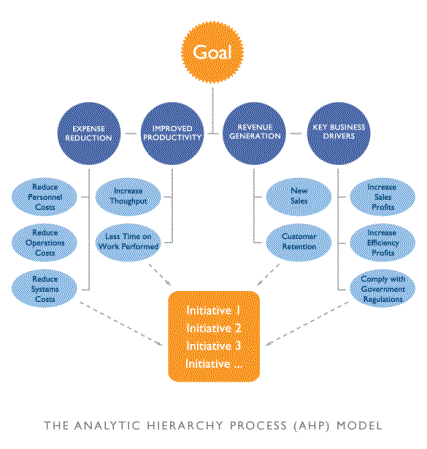The Analytic Hierarchy Process (AHP) is a framework that enables decision makers to structure decisions hierarchically with the overall goal at the top of the decision framework, strategic objectives at the higher levels, evaluation criteria in the middle levels, and alternative choices at the bottom.
The Rational Framework for Making Decisions
-
Set priorities on each level of the hierarchy using pairwise comparisons. At a given level on the hierarchy, decision makers evaluate each pair of decision factors, and make judgments as to their relative importance.
-
Structure decision criteria and create a model of stakeholder priorities. The weight of the decision is distributed downwards from the top goal.
-
Test the impact of changing priorities using AHP sensitivity analysis. Using sensitivity analysis, decision makers increase the weight of a criterion; testing the impact of changing priorities on alternative business decision choices.
-
Define business rules for budget allocation for a true portfolio-based framework. Define business rules for budget allocation using Decision Lens optimizer. Users can then allocate resources across investment alternatives to maximize business value.
-
Optimization enables decision makers to effectively manage investments in projects and people using a true portfolio-based framework instead of a project-based framework.

AHP provides a structured framework for setting priorities on each level of the hierarchy using pair-wise comparisons, a process of evaluating each pair of decision factors at a given level on the model for their relative importance with respect to their parent.
Decision lens tracks the consistency of judgments using the rigorous math analytics behind the Analytic Hierarchy Process to validate the decision process. In cases where inconsistency is above 10%, decision makers should revisit the criteria and judgments. Decision makers are then able to create a model of their priorities where the weight of the decision is distributed from the goal downwards. If a user increases the weight of a criterion, the alternatives that performed well on that criterion will always get higher scores. This sensitivity analysis is portrayed graphically in the Decision Lens software products and is valuable for testing the impact of changing priorities on alternative business decision choices.